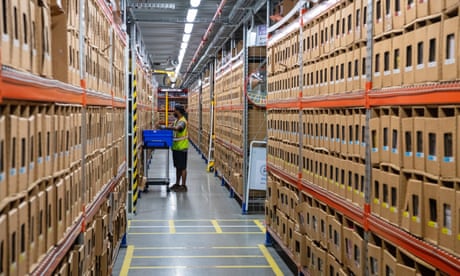- by foxnews
- 08 Apr 2025
Dream jobs brought them to Silicon Valley. Now they’re laid off and in an ‘impossible’ situation
Dream jobs brought them to Silicon Valley. Now they’re laid off and in an ‘impossible’ situation
- by theguardian
- 25 Dec 2022
- in technology

Less than a year ago, K was working with a US-based team at Amazon from one of the e-commerce giant's many international outposts in east Asia. While the distance between himself and those on his team had made his role tricky, he was at a stable job, at a company in his home country where labor laws protected workers from layoffs and sudden terminations.
To make it easier for him and his team to work together, Amazon offered him a role in the US and said it would sponsor his L visa - a temporary worker visa available to employees of US-based companies who transfer from an international office. Though that meant uprooting his family, including his children who did not speak English, K took the job, confident in the importance of his department, the Amazon's devices team, to the company.
But just seven months later, Amazon laid off 10,000 workers. K was one of them.
K is over 30 days into the 60 days he and other workers on temporary work visas are allotted to find another job before their visa expires and their ability to stay in the US is in limbo. But unlike those in the US on an H-1B visa - another type of temporary work visa widely used by tech companies - his best chance at staying in the US would be to find another role at the company that just laid him off. Companies can only sponsor L visas for people who have worked in one of their international offices for at least a year, so K would not be able to easily transfer to another US-based company that he hasn't already been employed by.
"The best way [to stay in the US] is to find a role within Amazon, but Amazon is freezing hiring now," K whose name and country of origin the Guardian is masking to avoid jeopardizing his job and immigration prospects, said. "So it's generally kind of impossible."
For years, thousands of engineers and other tech workers from all over the world have made the decision to uproot their lives and move to the US for a major tech firm gig. Historically, tech companies have grown at a breakneck pace, hiring hordes of new employees every year and making the decision to move to the US for a tech job a safe bet. But over the last few months the tech industry has been in a period of upheaval. In an apparent retrenchment, companies have conducted mass layoffs after pouring their war chest of funding and resources into chasing the Covid pandemic's explosive but fleeting growth in demand.
In addition to Amazon, Facebook has laid off more than 11,000 workers, Twitter has laid off 3,700 employees and even Google has initiated a hiring freeze. While there are no clear numbers on how many of those workers are on temporary work visas, immigration attorneys say they have seen an influx of new clients and new inquiries from existing clients who have been laid off and are seeking options for staying in the US.
"I was not at all concerned when I came here, but now I am," K said. "I would definitely not recommend people move here for a job in tech based on my experience."
Even when tech jobs are plentiful and the industry is stable, living in the US on a temporary work visa has always been relatively precarious. Still, the opportunities Silicon Valley offered remained attractive to foreign workers. In 2018, the last year for which data is sorted by employer, tech firms Amazon, Apple, Google and Facebook filed H-1B petitions for over 16,500 workers. Amazon filed more than 6,100 of those petitions. By 2022, Amazon increased that number to more than 18,000 petitions.
But that may change after the last few months.
Immigrant tech workers on temporary visas have always had fewer options than green card holders or citizens: their visas, and thus their ability to live in the US, are tied to their employers. Even when done voluntarily, switching jobs can be a gamble, in some cases literally. Workers with H-1B visas, for instance, need to find an employer that is willing to apply for and sponsor a new H-1B visa. If and when the application is submitted to US Citizenship and Immigration Services (USCIS), it is entered into a lottery to determine which applications will be considered. If their application happens to win the lottery, USCIS will evaluate whether to grant them H-1B status.
This thorny and complex system often leaves people with H-1B visas feeling stuck in the role they have, unwilling to take the risk of losing their status by switching to another company. Those who are laid off from their jobs are left to navigate the same system with the added pressure of finding another job within 60 days.
For those who are on the path to receiving a green card, being laid off can be a devastating setback. Depending on how far they got in the often years-long application process, they may lose their place in line and have to start over. Employers of H-1B workers can apply for a green card on their behalf through a three-step process that includes testing the labour market to prove they can't find a US worker to fill their positions. Like the H-1B process, the green card system is also a lottery, but it is quota-based. The US assigns a quota for the number of green cards it grants to people from each country. Due to the large number of immigrants from India and China - where many tech workers are from - there is a years-long backlog for green cards for workers from those countries.
"There's some people that predict if you were born in India and the job that you're taking only requires a bachelor's degree, for example, that it may take a decade to be able to get through that process," said Kristi Nevarez, a partner at law firm Fragomen, Del Rey, Bernsen & Loewy LLP, a law firm that works with tech and other companies applying for temporary work visas on behalf of employees.
While much attention has been paid to the predicament of workers on H-1B visas, fewer people know about the more limiting L visas. Because it is only available to people who are transferring from their employer's international office to an office in the US, they cannot simply seek a job at another company in the hopes that the new company will sponsor their L visa. They would need to apply for a change of status by, for example, looking for a company that would sponsor an H-1B visa for them. But that comes with its own risks: their application would only be considered if it was picked in the lottery.
When workers on temporary work visas lose their jobs, it's often not just their own immigration status that is in flux. For instance, spouses of workers with L-1 visas are eligible for L-2 visas, which authorize them to work. But if an L-1 visa holder loses their job and then their status, so too does their spouse.
K's family has lost both sources of income.
"After the layoff, [my wife] will not be able to work as well," he said.
K thinks his best bet is to return to east Asia. "I feel like I have more opportunity there," he said, because there are laws there that make it "really hard for a company to lay off people".
K's already limited options are made more so by the lack of hiring at Amazon. He says there are few open roles at the company, and managers are rushing to fill those that are open for fear of losing the headcount in the new year.
"The economic situation is such that these companies and the alternative companies that people would go to are also not hiring," said Tahmina Watson, an attorney and member of the advocacy committee at the American Immigration Lawyers Association. "They're either laying people off or they're having a hiring freeze. So the situation is such that their roads are essentially blocked."
Amazon declined to comment but pointed the Guardian to company CEO Andy Jassy's statement on the layoffs on the devices and books teams. "We are working to support those who are affected and trying to help them find new roles on teams that have a need; and in cases where that's not possible, we are offering packages that include a separation payment, transitional health insurance benefits, and external job placement support," his statement reads.
For H-1B workers, the picture is not as bleak. They can still apply at other companies, and Nevarez, the attorney at Fragomen, Del Rey, Bernsen & Loewy LLP, said at this point laid-off tech workers may have more options if they are flexible about the industry, size and geographical location of the companies they are applying to.
"There are companies that are in need of tech talent across all industries," Nevarez said. "It's also geographically diverse. Maybe it's not sitting in Silicon Valley, maybe it's sitting in Texas or North Carolina. But again, if you're living here in Silicon Valley, you're picking up your life and moving to another location to essentially start over, at least from a community perspective, if not from an employment perspective."
- by foxnews
- descember 09, 2016
Ancient settlement reveals remains of 1,800-year-old dog, baffling experts: 'Preserved quite well'
Archaeologists have recently unearthed the remarkably well-preserved remains of a dog from ancient Rome, shedding light on the widespread practice of ritual sacrifice in antiquity.
read more





